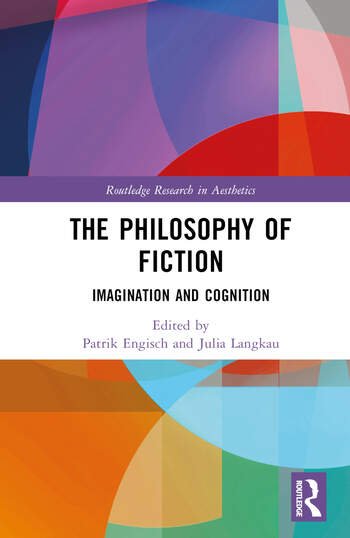This week at The Junkyard we’re hosting a symposium on Patrik Engisch and Julia Langkau’s (eds.) recent book: The Philosophy of Fiction: Imagination and Cognition. Today we begin with an introduction from Patrik Engisch and Julia Langkau. Commentaries will follow Tuesday through Thursday.
Recent philosophy of fiction in the analytic tradition has concerned itself extensively with the distinction between fiction and non-fiction and why this distinction matters. Following the pioneering work of Kendall Walton (1990), Gregory Currie (1990) and Peter Lamarque & Stein Haugom Olsen (1994), three general theses have been particularly scrutinized: one concerning the definition of fiction, one concerning our engagement with fiction, and one concerning our learning from fiction. The volume presents new research on each of these theses.
Patrik Engisch is a post-doc researcher at the University of Geneva where he is a member of the SNFS Prima research project “Creativity, Imagination, and Tradition”. His interests span across the philosophy of mind, aesthetics, and the philosophy of food. He is the co-editor of The Philosophy of Recipes: Making, Experiencing, and Valuing (Bloomsbury 2022) and The Philosophy of Fiction: Imagination and Cognition (Routledge 2023).
Julia Langkau is an Assistant Professor at the University of Geneva. She’s leading the SNFS Prima project “Creativity, Imagination and Tradition”. Her main research areas are philosophy of mind, philosophy of fiction, epistemology and aesthetics. She also writes literary fiction.
The first thesis is that the notion of fictional representation can be defined in terms of prescriptions to imagine. This thesis can be understood as a metaphysical one and is standardly framed in a realist spirit. It says that our ontology contains two mutually exclusive sub-kinds of representations: fictional and non-fictional ones. While some philosophers have understood this distinction as pertaining to works, i.e., narrative representations taken as a whole, others have suggested that we understand the distinction as applying to sentences or the propositions they express. Most contributions to this volume seem to commit to the first. It is this notion that is also most relevant when discussing the question of the nature of our engagement with fiction (second thesis), and of whether we can learn from fiction (third thesis). Concerning the first thesis, the contributions to this volume question the idea that we can define fiction through imagination. Richard Woodward’s “Projecting Fiction” puts forth a novel, expressivist approach to defining fiction. According to such an approach, a judgment of the form “x is fiction” is not a recognition of the fact that x possesses the property of being fiction but, rather, an expression of a non-cognitive attitude. Patrik Engisch’s “Imagination, Fiction, and Narrative” focuses on the recent debate over the attempt to define fiction in terms of prescriptions to imagine and develops the idea that our engagement with narratives broadly is to be accounted for in terms of a deflationist conception of imagination. Derek Matravers’ “Fiction and the Actual World” replies to an objection to his influential view on the nature of fiction (Matravers 2014). Fictional and non-fictional contexts suggest different treatments of propositions that are part of a narrative but that are inconsistent with what we believe: we accommodate them in the context of fiction while rejecting them in the context of non-fiction. Matravers argues that if we look at fiction and non-fiction in terms of representations and our engagement as reading and building a mental model, all strategies are available for fictional and non-fictional models. Margherita Arcangeli’s “The Creative Side of Recreative Imagination” tackles the question of the nature of the imaginative capacities we put into play in our crafting of, and engagement with, fiction.
The second thesis says that works of fiction and non-fiction call for distinct kinds of engagement and give rise to different experiences. One obvious way to commit oneself to this idea is to endorse the first thesis: that the notion of fictional representation can be defined in terms of prescriptions to imagine. Imagination could thus provide us with a definition of fiction on the one hand and an account of our engagement with it on the other. However, proponents of this view have disagreed in substantial ways about what engaging with a work of fiction imaginatively amounts to. The thesis can also be understood in a variety of other ways, depending on whether we have psychological, behavioral, epistemic, aesthetic, or ethical aspects in mind. In recent research, we can observe a shift away from attempts to clearly distinguish engagement with fiction from engagement with non-fiction and towards spelling out in detail the specific aesthetic, experiential and genuinely emotional aspects of our experience of fiction. Manuel García-Carpintero’s “Fictional Narrators and Normative Fiction-Making” is concerned with covert narrators and develops an account of so-called “silly questions” in order to defend the claim that the presence of such narrators is to be assessed only on aesthetic grounds. Eileen John’s “The Experience of Fiction” claims that what is distinctive about our engagement with fiction may not lie in the reader’s attitude of imagining as opposed to believing, but instead in the kind of experience we have as a consequence of the author’s lapsing the fidelity constraint. Magdalena Balcerak Jackson and Julia Langkau’s “Literary Fiction and Imagination” challenges the idea that propositional imagination plays a crucial role in our engagement with fiction. The authors argue that a different kind of imagination, namely phenomenal or experiential imagining, can account for our intuition that imagination and fiction are closely tied. Anna Cristina Ribeiro’s “The Gift of the Lyric” is concerned with the representational status of lyric poetry. She defends the claim that the lyric poem promotes engagement with the actual lived experience or thoughts and sentiments of poets, rather than with mere possibilities. Fiora Salis’ “Keeping it simple. Fiction, Imagination and the Emotions” offers a new take on the paradox of fiction. Salis argues that for one’s emotion towards fiction to be genuine, one only needs good grounds or justification for it. And such justification can be provided by developing an adequate theory of our emotional responses to fiction, one that gives due place to imagination as a source of justification for emotions.
The third thesis is that it is possible for fictional works to contribute to our learning about non-fictional truths, practices, and experiences. Often referred to as “cognitivists,” one broad group of philosophers answer the question of whether we can learn from fiction positively. The label “non-cognitivists” can be applied to two different kinds of authors. On the one hand to “strong non-cognitivists”, who don’t think we can learn from fiction and, on the other hand, to “weak non-cognitivists” who answer the question positively, though with a major qualification: they think that works of fiction can be a source of learning, but deny that they can be such as works of fiction or when engaged with as such. For instance, some have argued that we can empathize with fictional characters in the same way as we can empathize with real people and, thereby, gain vicarious knowledge of (fictional) mental states like thoughts and experiences. Other authors have argued that engagement with works of fiction can foster our cognitive skills if not enable us to acquire new ones, such as imagining and empathizing. The contributions to this volume focus on non-propositional forms of knowledge such as a certain awareness of the world, empathy, and skills. María José Alcaraz León’s “More than Make-Believe: On the Uses of Imagination in Experiencing Fictional Artworks” argues that we engage with works of artistic fiction by combining two forms of imagining, one that brings to the fore the way imagination can play a role in organizing experience and another one that helps considering the content of works of artistic fiction with a kind of cognitive distance. The two forms of imagination combined can give rise to an experience of works of fiction that is reflexive and that allows us to become aware of certain aspects of the way we experience the world. Olivia Bailey’s “Empathy, Sensibility, and the Novelist’s Imagination” critically engages with the often-held claim that works of fiction can allow us to empathize with a wide range of fictional characters, including some that have sensibilities foreign to us. Anna Ichino’s “Conspiracy Theories as Walt-Fiction” scrutinizes the popular claim that conspiracy theories are fictions and argues that many cases of endorsement of conspiracy theories can be described in terms of games of make-believe in which such theories are used as props. Amy Kind’s “Fiction and the Cultivation of Imagination” is concerned with the question of whether a work of fiction can foster our imaginative skills and, thereby, help subjects become better imaginers. She argues in favor of a positive answer to that question with respect to several kinds of imaginative capacities, including empathetic imagination, examining both empirical and philosophical literature.
References:
Currie, G. (1990). The Nature of Fiction. Cambridge: Cambridge University Press.
Lamarque, P. and Olsen, S.H. (1994). Truth, Fiction, and Literature. Oxford: Clarendon Press.
Matravers, D. (2014). Fiction and Narrative. Oxford: Oxford University Press.
Walton, K. (1990). Mimesis and Make-Believe. Cambridge, MA: Harvard University Press.



